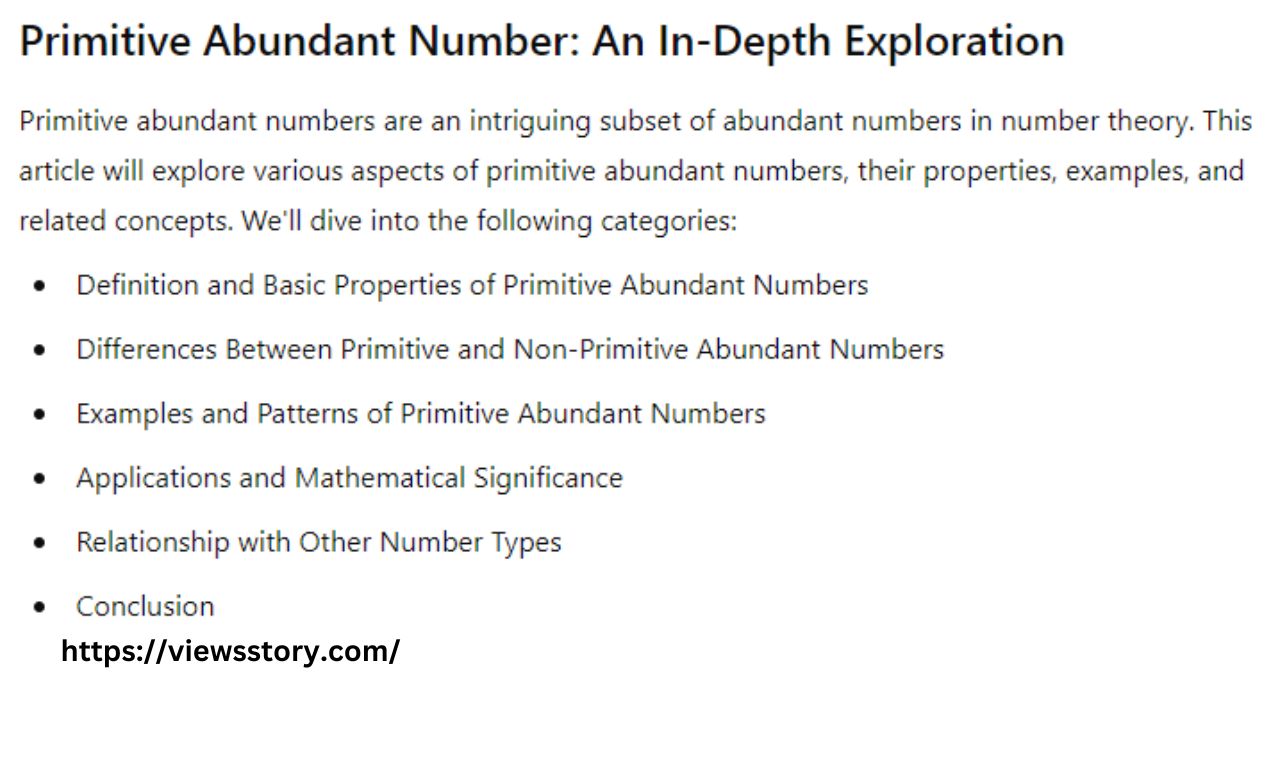Primitive abundant numbers are an intriguing subset of abundant numbers in number theory. This article will explore various aspects of primitive abundant numbers, their properties, examples, and related concepts. We’ll dive into the following categories:
- Definition and Basic Properties of Primitive Abundant Numbers
- Differences Between Primitive and Non-Primitive Abundant Numbers
- Examples and Patterns of Primitive Abundant Numbers
- Applications and Mathematical Significance
- Relationship with Other Number Types
- Conclusion
What is a Primitive Abundant Number?
Primitive abundant numbers are a special type of number in which the sum of the proper divisors is greater than the number itself, and this property is not derived from any smaller number. In other words, a primitive abundant number cannot be formed by adding proper divisors of a smaller abundant number.
Characteristics of Primitive Abundant Numbers
- Definition: A number nnn is called an abundant number if the sum of its proper divisors (excluding itself) is greater than nnn.
- Primitive Abundant Property: A primitive abundant number cannot be divided in such a way that the resulting smaller numbers are also abundant.
- Unique Nature: Each primitive abundant number is uniquely abundant in its own way and doesn’t derive its properties from any smaller numbers.
Differences Between Primitive and Non-Primitive Abundant Numbers
Understanding the distinction between primitive and non-primitive abundant numbers is crucial. Here’s how they differ:
Primitive Abundant Numbers
- Definition: Cannot be written as a sum of the divisors of any smaller abundant number.
- Example: The number 20 is a primitive abundant number because its proper divisors (1, 2, 4, 5, 10) add up to 22, which is greater than 20, and there are no smaller abundant numbers that share this property.
Non-Primitive Abundant Numbers
- Definition: Can be represented by the sum of the divisors of smaller abundant numbers.
- Example: The number 24 is not a primitive abundant number because it can be derived from the divisors of 12, which is an abundant number itself.
Examples and Patterns of Primitive Abundant Numbers
Let’s look at some primitive abundant numbers and the patterns they follow.
List of Primitive Abundant Numbers
- The first few primitive abundant numbers are 20, 70, 88, 104, 272, and so on.
- Pattern Observation: These numbers often have unique factorization properties that set them apart from other abundant numbers.
Detailed Example: Analyzing 20 as a Primitive Abundant Number
- Proper divisors: 1, 2, 4, 5, 10
- Sum of divisors: 1 + 2 + 4 + 5 + 10 = 22
- Since 22 > 20 and there are no smaller abundant numbers contributing to 20’s property, 20 is considered a primitive abundant number.
Applications and Mathematical Significance of Primitive Abundant Numbers
Primitive abundant numbers have unique mathematical significance and can be used in various applications:
Number Theory and Research
- Primitive abundant numbers are studied to understand the distribution of abundant numbers and their relationship with other types of numbers.
Cryptography and Algorithms
- The properties of primitive abundant numbers are used in certain cryptographic algorithms where factorization plays a role.
Relationship with Other Number Types
Primitive abundant numbers are connected to other number types such as perfect numbers, deficient numbers, and amicable numbers.
Primitive Abundant vs. Perfect Numbers
- A perfect number is one where the sum of its proper divisors equals the number itself.
- Example: The number 28 is a perfect number, while 20 is a primitive abundant number, illustrating how these types differ in divisor properties.
Primitive Abundant vs. Deficient Numbers
- A deficient number has a sum of proper divisors less than the number itself.
- Example: The number 15 is deficient, as its proper divisors (1, 3, 5) add up to 9, which is less than 15.
Conclusion
Primitive abundant numbers are a fascinating category within number theory that hold unique properties distinguishing them from other types of numbers. Their inability to be derived from smaller abundant numbers makes them a valuable area of study in mathematical research and applications. Understanding the characteristics and patterns of these numbers can shed light on the broader behavior of integers and their divisors.






